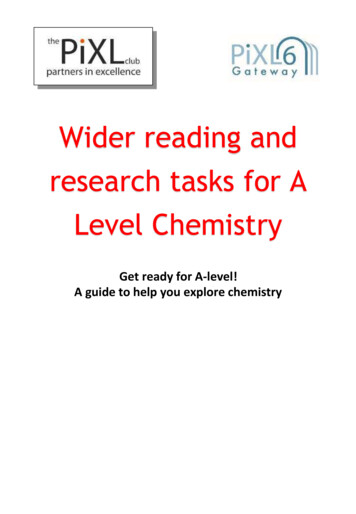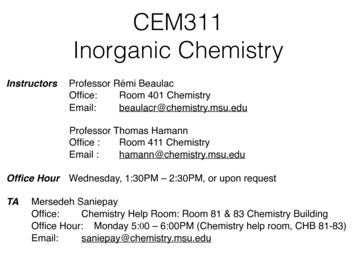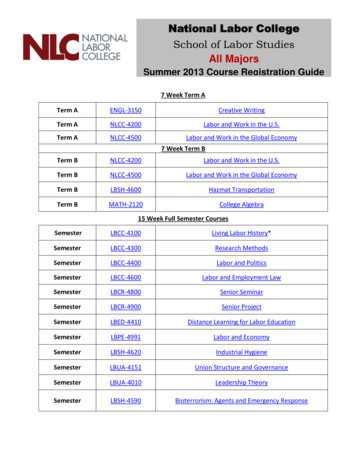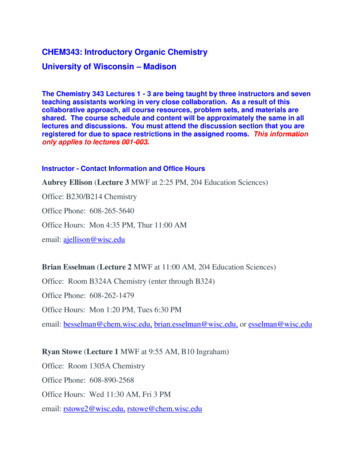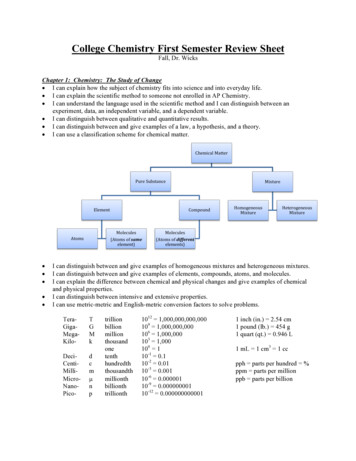
Transcription
College Chemistry First Semester Review SheetFall, Dr. WicksChapter 1: Chemistry: The Study of Change I can explain how the subject of chemistry fits into science and into everyday life. I can explain the scientific method to someone not enrolled in AP Chemistry. I can understand the language used in the scientific method and I can distinguish between anexperiment, data, an independent variable, and a dependent variable. I can distinguish between qualitative and quantitative results. I can distinguish between and give examples of a law, a hypothesis, and a theory. I can use a classification scheme for chemical matter.Chemical MatterPure SubstanceElement CompoundMolecules(Atoms of neousMixtureMolecules(Atoms of differentelements)I can distinguish between and give examples of homogeneous mixtures and heterogeneous mixtures.I can distinguish between and give examples of elements, compounds, atoms, and molecules.I can explain the difference between chemical and physical changes and give examples of chemicaland physical properties.I can distinguish between intensive and extensive properties.I can use metric-metric and English-metric conversion factors to solve 1012 1,000,000,000,000109 1,000,000,000106 1,000,000103 1,000100 110-1 0.110-2 0.0110-3 0.00110-6 0.00000110-9 0.00000000110-12 0.0000000000011 inch (in.) 2.54 cm1 pound (lb.) 454 g1 quart (qt.) 0.946 L1 mL 1 cm3 1 ccpph parts per hundred %ppm parts per millionppb parts per billion
College Chemistry First Semester Review Sheet, Page 2 I can convert between oF, oC, and K.o 5 C ( o F 32 ) 9 o 9 F oC 32 5 K oC 273.15I can explain the difference between precision and accuracy.I can apply the rules for using significant figures in calculations.I can use dimensional analysis for problem solving.I can use densities and percents as conversion factors in problem-solving.Chapter 2: Atoms, Molecules, and Ions I can describe how Dalton’s atomic theory explained the law of conservation of mass, the law ofdefinite proportions (law of constant composition), and the law of multiple proportions. See Table 1.Table 1: Laws Explained by Dalton’s Atomic TheoryLawLaw of Conservation of MassLaw of Definite Proportions(Law of ConstantComposition)Law of Multiple Proportions MeaningMatter can be neither created nor destroyed.Different samples of the same compound always contain its constituentelements in the same proportions by mass.If two elements can combine to form more than one compound, themasses of one element that combine with a fixed mass of the otherelement are in ratios of small whole numbers.I can explain the historical development of atomic theory and identify some of the scientists who havemade important contributions.I can explain the significance of Millikan’s oil drop experiment and Rutherford’s gold foilexperiment.I can describe the structure of the atom using protons, neutrons, and electrons.Given atomic numbers and mass numbers, I can calculate the number of protons, neutrons, andelectrons in atoms of given elements.I can explain what isotopes are and how isotopic abundance can be used to calculate the atomic massof an element.Given a periodic table of the elements, I can identify the location of groups, periods, metals,nonmetals, metalloids (semimetals), alkali metals, alkaline-earth metals, halogens, noble gases, andtransition metals.I can give examples of allotropes.I can use the periodic table to determine charges for ions of given elements.I know the names, chemical formulas, and charges for common polyatomic ions.H 3O NH4 OHC 2H 3O NitrateNitriteHCO3CO32SO42PO43HPO42H2PO4-Hydrogen Carbonate(also called Bicarbonate)CarbonateSulfatePhosphateHydrogen PhosphateDihydrogen ichromate
College Chemistry First Semester Review Sheet, Page 3 I can combine cations and anions to write formulas for ionic compounds.I can rapidly distinguish ionic compounds (metal and nonmetal elements) from molecular compounds(nonmetal elements only) for chemical nomenclature purposes.I can use the following prefixes to write the names for molecular compounds.Mono- (1), di- (2), tri- (3), tetra- (4), penta- (5), hexa- (6), hepta- (7), octa- (8), nona- (9), deca- (10) I can write chemical names given chemical formulas and vice versa for ionic compounds, molecularcompounds, acids, bases, and hydrates.Chapter 24: Organic Chemistry I can draw structures and name alkanes containing up to ten carbons. See Table 2. I can identify cis- and trans- isomers from the structures of simple alkenes. I can identify alkanes (CnH2n 2), alkenes (CnH2n), and alkynes (CnH2n-2) from their structures andmolecular formulas. (In a later chapter, we will compare and contrast the characteristics of single,double, and triple bonds in these compounds.)Table 2: Straight Chain Alkanes Containing 1 – 10 CarbonsMolecular FormulaExpanded Molecular FormulaNameCH4CH4MethaneC 2H 6CH3CH3EthaneC 3H neC10H22CH3CH2CH2CH2CH2CH2CH2CH2CH2CH3Decane
College Chemistry First Semester Review Sheet, Page 4Chapter 3: Mass Relationships in Chemical Reactions I can calculate an element’s average atomic mass from the atomic mass and natural abundance datafor multiple isotopes of the same element. I understand the chemical mole, and I can calculate the number of atoms or molecules present usingAvogadro’s number, 6.022 x 1023 particles/mole. I can calculate the molar mass for a chemical formula from the atomic masses on a periodic table ofthe elements. I can use Avogadro’s number and molar masses as conversion factors to solve problems. I can express molecular composition in terms of percent composition. Remember it is helpful toassume you have one mole of a given compound during problem solving. Mass of Element % Composition of an Element in a Compound (100 ) Mass of Compound I can solve empirical formula problems using the strategy outlined in Table 3.I can use percent composition to determine the empirical formula of a compound. Remember it ishelpful to assume you have 100 g of a given compound during problem solving.I can use experimental data to calculate the number of water molecules in a hydrated compound. SeeTable 3.Table 3: Problem Solving Strategies for Empirical Formulas and Hydrate Formulas1.2.3.4.5. Empirical Formula CalculationsGet mass of each elementGet molesGet mole ratioUse whole number multiplier if neededWrite the empirical formula1.2.3.4.5.Formula of a Hydrate CalculationsGet mass of water and anhydrous saltGet molesGet mole ratio(Whole number multipliers are rarely needed)Write the formula of the hydrateI can obtain a molecular formula from an empirical formula using the molar masses of both. Recall MM Molecular Formula Whole Number Multiplier needed to obtain the molecular formula. MM Empirical Formula that I can balance simple chemical equations by inspection and complicated chemical equations by usingthe fraction method.I can balance chemical equations so that they have both material balance and charge balance.I can use reaction stoichiometry to interpret a chemical equation on a microscopic (molecular) leveland a macroscopic (molar) level.I can calculate the mass (or moles) of one reactant or product from the mass (or moles) of anotherreactant or product in a balanced chemical equation.I can determine which reactant is the limiting reactant in a balanced chemical equation. I can alsodetermine the amount of product formed and the amount of excess reactant leftover.I can distinguish between actual yield, theoretical yield, and percent yield. Actual Yield (100 ) Theoretical Yield I can calculate theoretical yield and percent yield. % Yield I can use stoichiometry principles to analyze a mixture or to find the empirical formula of anunknown compound.
College Chemistry First Semester Review Sheet, Page 5Chapter 4: Reactions in Aqueous Solution I can explain the difference between a strong electrolyte, a weak electrolyte, and a nonelectrolyte. I can use the solubility rules to predict the solubility of ionic compounds in water. See Table 4. I can write the ions formed when an ionic compound dissolves in water. I can predict products for precipitation reactions (double replacement reactions). I can write molecular, ionic, and net ionic equations, and I can identify spectator ions. I can recognize common acids and bases. I can explain the difference between strong and weak acids and strong and weak bases. I can write equations for acid ionization and base dissociation. I can write molecular, ionic, and net ionic equations for acid-base neutralizations (double replacementreactions). I understand that when acid-base reactions form “salts,” this does NOT mean that they all form tablesalt, NaCl. The word “salt” in this context refers to an inorganic compound whose cation comes froma base and whose anion comes from an acid.Table 4: Solubility Rules for Common Ionic Compunds in Water at 25oCGeneral RuleExceptions to the RuleAlmost all compounds containing alkali metal ions(Li , Na , K , etc.) and NH4 are solubleAlmost all compounds containing nitrates (NO3-),bicarbonates (HCO3-), and chlorates (ClO3-) aresolubleMost compounds containing halides (Cl-, Br-, and I-)are solubleHalides of Ag , Hg22 , and Pb2 Most sulfates (SO42-) are solubleSulfates of Ag , Ca2 , Sr2 , Ba2 , Hg22 , and Pb2 Carbonates (CO32-), phosphates (PO43-), chromates(CrO42-), and sulfides (S2-) are usually insolubleCompounds containing alkali metal ions (Li , Na ,K , etc.) and NH4 Hydroxides (OH-) are usually insolubleHydroxides containing alkali metal ions (Li , Na ,K , etc.) and Ba2 I can identify Bronsted acids and Bronsted bases.I can predict the products of simple gas forming reactions.I can identify and write balanced chemical equations for four common types of reactions in aqueoussolution:1. precipitation reactions - form a solid that does not dissolve in water (double replacement).2. acid-base reactions - form a “salt” and water (double replacement).3. gas-forming reactions - form a gas like CO2.4. oxidation-reduction reactions - transfer electrons (combination, decomposition, combustion,and single replacement).I can use an activity series to predict whether a single replacement reaction will occur.
College Chemistry First Semester Review Sheet, Page 6 I can calculate oxidation numbers for elements in a compound.I can recognize “redox” reactions (oxidation-reduction reactions) and write simple half reactions.I can identify oxidizing agents and reducing agents. (Recall “OIL RIG,” which stands for “oxidationis loss” and “reduction is gain.”I understand how molarity is used as a unit for concentration.I can calculate the molar concentration of ionic substances dissolved in water using Moles of Solute Molarity Liters of Solution I can prepare solutions of various molar concentrations:1. from solids.2. by diluting liquids. (Recall C1V1 C2V2 where C concentration and V volume.)I can solve stoichiometry problems involving concentrations.I can perform a “titration” and a “standardization” experimentally and determine the unknownconcentration for a reactant.Chapter 19: Electrochemistry I can balance redox equations using the ion-electron method. Here are the steps for balancing a redox equation occurring in acidic solution:1. Divide the equation into two half reactions2. Balance atoms other than H and “O”3. Balance “O” by adding water4. Balance H by adding hydrogen ion5. Balance the net charge by adding electrons6. Make electron gain electron loss, and add the half-reactions7. Cancel anything the same on both sides of the final equation Here are the steps for balancing a redox equation occurring in basic solution:1. Divide the equation into two half reactions2. Balance atoms other than H and “O”3. Balance “O” and H by adding water and hydroxide ion4. Balance the net charge by adding electrons5. Make electron gain electron loss, and add the half-reactions6. Cancel anything the same on both sides of the final equationChapter 5: Gases I understand how pressure measurements are made. I can convert between various pressure units: 1atm 760 mm Hg 760 torr 101.3 kPa 14.7 psi I know the standard conditions of temperature and pressure (STP) are 0oC (273 K) and 1 atm. I recall that all temperature-related gas laws use Kelvin rather than Celsius temperature. I understand that absolute zero on the Kelvin scale is the temperature at which all atomic andmolecular motion stops. It can be determined by extrapolating a line to zero volume on a V-Tdiagram (Charles’ law) or by extrapolating a line to zero pressure on a P-T diagram (Gay-Lussac’slaw). I can distinguish between Boyle’s law, Charles’ law, Gay-Lussac’s law, Avogadro’s law, thecombined gas law, the ideal gas law, Dalton’s law, and Graham’s law, which are presented in Table 5along with values for the gas law constant, R .
College Chemistry First Semester Review Sheet, Page 7 I can calculate gas densities and molar masses by substituting n PV nRT , to get d m PMM VRTand MM mMMinto the ideal gas law,mRT dRT. PVPI understand that the volume occupied by one mole of an ideal gas at standard conditions oftemperature and pressure (STP, 0oC and 1 atm) is 22.4 L/mole, and I can use this conversion factor inproblem solving.I can apply the gas laws when solving stoichiometry problems involving gaseous materials.I understand that the partial pressure of a gas in a mixture, PA , is given by its mole fraction, X A ,multiplied by the total pressure of the mixture, Ptotal : PA X A Ptotal . (The mole fraction of acomponent A in a mixture is defined as the number of moles of A divided by the total moles of allcomponents.)I can apply the kinetic-molecular theory of gas behavior at the molecular level.1.KE 1 2mu where KE average kinetic energy of the gas molecules, m mass of the gas,22 and u the average of the squares of the molecular speeds.2. Since KE is determined by temperature, heavier molecules move with a slower average speedthan lighter molecules at a given temperature.3. For a given gas, the only way to change its average KE is to change its temperature.I can distinguish between ideal gases and real gases. Ideal gas molecules are assumed to have novolume and to not interact with one another by intermolecular forces. Deviations from ideal behaviorare greatest at high pressure and low temperature.Ideal gas characteristics:1. Gases are composed of very tiny molecules with lots of empty space between them.2. Gas molecules move rapidly, move in straight lines, and travel in random directions.3. Gas molecules do not attract each other.4. Gas molecules have elastic collisions. In other words, the total kinetic energy of themolecules before and after a collision is the same.5. The average kinetic energy of gas molecules is proportional to the absolute (Kelvin)temperature.In kinetic theory, the molecules of a gas are imagined to be a large number of points bouncing off thewalls of a container. I understand that gas pressure is related to the number of collisions that occurwith the walls per unit time.I can calculate the root mean square (rms) speed of molecules in a gas at Kelvin temperature T usingurms 3RTMMwhere MM is the molar mass in kg/mole.I can compare and contrast diffusion and effusion and I know how to use Graham's Law. Graham'sLaw states that the rates of diffusion (or effusion) of two gases are inversely proportional to thesquare roots of their molar masses at the same temperature and pressure: r1 r2MM 2MM 1When studying the behavior of real gases, I can use the van der Waals equation: an 2 P (V nb ) nRT where a and b are van der Waals constants which correct for V 2 intermolecular forces and molecular volume.
College Chemistry First Semester Review Sheet, Page 8Table 5: Gas LawsEquationGas Law NameQuantities Held ConstantBoyle’s Law:PV1 1 PV2 2Temperature and molesCharles’ Law:(Absolute zero, 0 K, can bedetermined by extrapolating aline to zero volume on a V-Tdiagram.)V1 V2 T1 T2Pressure and molesGay-Lussac’s Law:(Absolute zero, 0 K, can bedetermined by extrapolating aline to zero pressure on a P-Tdiagram.)P1 P2 T1 T2Volume and molesAvogadro’s Law:(Stoichiometric coefficients canbe used to compare volumes ofdifferent gases in a chemicalequation,)V1 V2 n1 n2Temperature and pressureCombined Gas Law:(Combines Boyle’s, Charles’, andGay-Lussac’s Laws)PVPV1 1 2 2T1T2MolesIdeal Gas Law:(Combines Boyle’s, Charles’, andAvogadro’s Laws)PV nRT whereR 0.0821 L-atm/(mole-K)NoneDalton’s Law:Total pressure is equal to the sumof the partial pressures.PTotal å PiNot applicableGraham’s Law:r1 r2Not applicable 8.314 J/(mole-K) Gas Law Constantni 1MM 2MM 1
Chapter 24: Organic Chemistry I can draw structures and name alkanes containing up to ten carbons. See Table 2. . College Chemistry First Semester Review Sheet, Page 6 I can calculate oxidation numbers for elements in a compound. I can recognize "redox" reactions (oxidation-reduction reactions) and write simple half reactions. .


